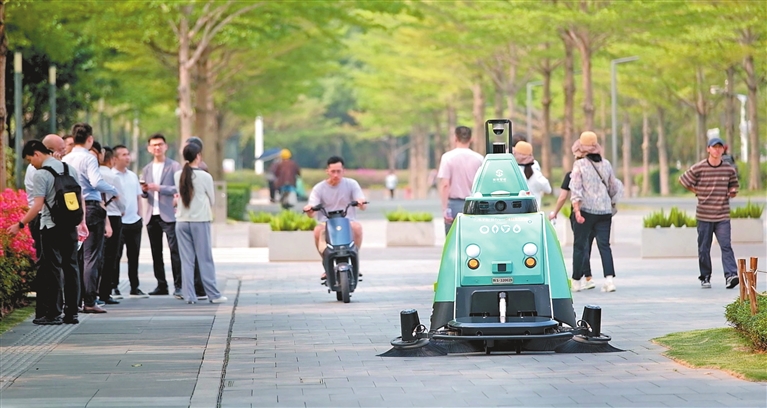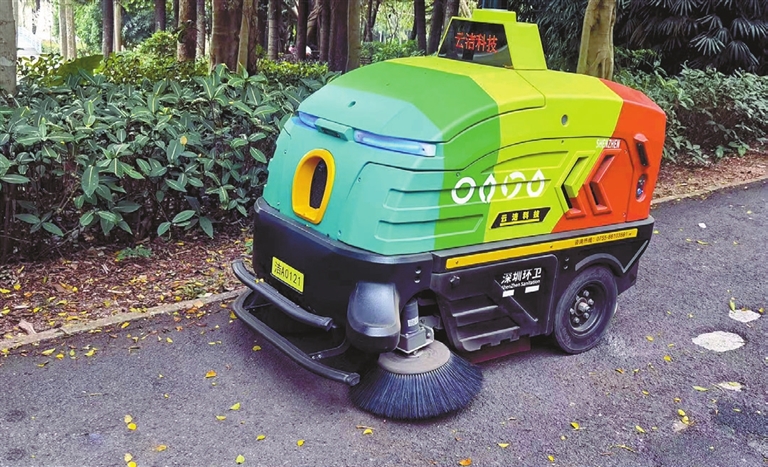

Editor’s Note: Since the annual “two sessions” concluded earlier this March, the phrase “new quality productive forces” has emerged as a buzzword and gained widespread attention in the context of China’s economic upgrading. Marked by innovation, new quality productive forces are advanced forms of productivity that represent a departure from traditional economic growth models. These forces align with China’s new development philosophy, which prioritizes innovation and sustainability. They encompass high tech, efficiency, and high-quality productivity methods. Han Ximin 1824295095@qq.com IN the dim light just before sunrise, as I walked along the road winding up to the summit of Lianhua Hill Park, an object ahead caught my attention, gradually moving closer and causing me to pause. The tranquility of the early morning amplified the buzz that emanated from it as it drew near. Intrigued, I inched forward, leaning in for a better view. It was a robot. Manufactured by Yunjie Technology, this robot, equipped with a waste bin and spraying mechanisms, diligently carried out its cleaning duties on the deserted streets while the world slumbered. Within the 3 square kilometers encompassing Lianhua Hill Park and the Civic Center in Futian CBD, a variety of robot models of various sizes have been deployed for cleaning on sidewalks and in parks and squares. “In the beginning, we were skeptical about the robots’ ability to clean effectively, but with practice, our coordination with the robots significantly boosted our efficiency,” a street cleaner surnamed Wen, who oversees the area surrounding the Shenzhen Book City CBD Store. Previously, maintaining the two adjacent squares required the effort of three to four individuals. Now, robots handle the basic cleaning tasks. This development allows cleaners to redirect their attention to areas like flower beds, which still require human maintenance. “Thanks to the robots, we no longer need to rise at dawn or endure long hours laboring under the blazing midday sun. These robots are dependable allies,” added Wen. According to Zheng, a technician at Shenzhen Saite Intelligence Co. Ltd., a fully charged robot can operate continuously for eight hours and clean approximately 6,000 square meters per hour. Competition in cleaning At the First Shenzhen (International) Intelligent Sanitation Cleaning Robot Competition, held at the Shenzhen World Exhibition & Convention Center last week, Saite Intelligence’s S330 sweeper clinched the top spot in the park and square category for its exceptional ability to ascend a 20-degree incline. The event, which showcased the latest advancements in AI-powered robots and robot models from around the world, epitomized the pinnacle of technological expertise in the industry. The competition assessed the robots’ ability to traverse obstacles and comprehensively evaluated their capabilities in scenarios like parks, squares, pavements, and non-motorized roads. “The competition serves as a pivotal annual event advancing the evolution of new productive forces and modernizing Shenzhen’s sanitation services, propelling industry growth and development,” said Huang Lixin, deputy director of the city’s urban management authority. Market dynamics Shenzhen’s strategic focus on artificial intelligence has fostered an enticing environment for investment, drawing in AI enterprises by bolstering policies, talent acquisition, computational resources, and financial incentives. In the competition, four AI sanitation companies based in other cities signed agreements to establish a presence in Shenzhen. Over 30 companies nationwide are currently engaged in the production and research of AI sanitation equipment and 30% of them are based in Shenzhen. “Shenzhen’s strength in talent, market viability, supportive policies, and technological infrastructure is propelling the rapid advancement of AI applications,” said Yang Fan, deputy general manager of Shenzhen Saite Intelligence Co. Ltd. Shenzhen’s robust market ecosystem and sophisticated commercial landscape, coupled with ample data resources in the urban sanitation sector, facilitate product advancements and evolutionary cycles, according to Yang. Shenzhen has created over 50 AI cleaning application scenarios that include municipal roads, urban villages, parks and squares, deploying over 150 robots. It has also launched an AI video inspection system and established the country’s first “5G+AI” intelligent supervision model for the entire process of garbage classification. | 
